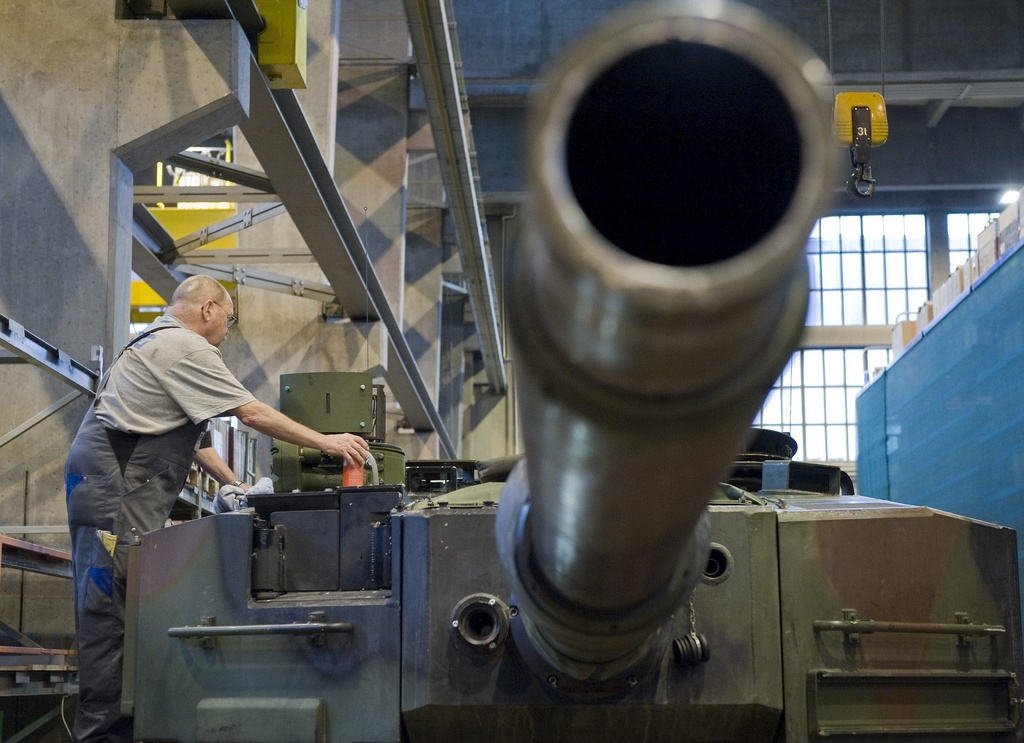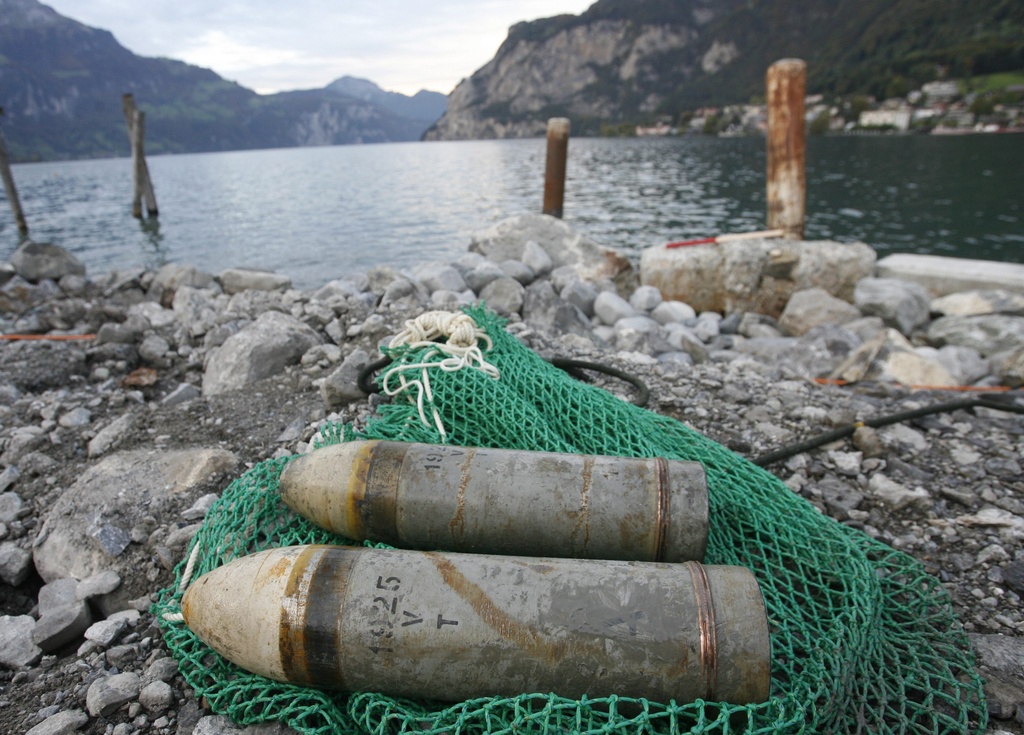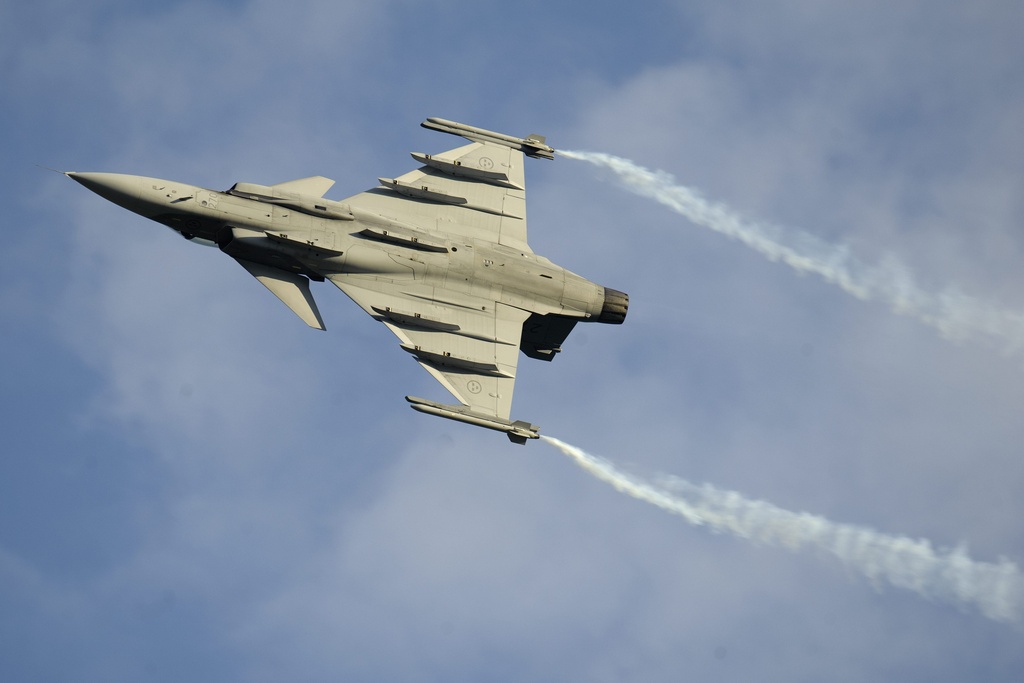War materiel exports return to the spotlight

Swiss law governing the exportation of war materiel has been criticised by legal experts as lacking transparency as regards the end-use of exports.
A study conducted by researchers at the universities of Bern and Zurich found that while Switzerland’s laws in this area are robust, more needs to be done to ensure they are enforced correctly.
The criticism follows the lifting of a six-month ban on weapons exports to Qatar last December, after it was found that munitions manufactured by Swiss company Ruag had been delivered to Libya in violation of the export agreement.
The State Secretariat for Economic Affairs (Seco), which has oversight of all exports of war equipment, attributed the delivery to a “military logistics error”.
Ruag, which is majority-owned by the Swiss government, said on Thursday exports accounted for 53 per cent of sales in 2011. Delivering full-year results, the company reported a 5.9 per cent increase in profits to SFr97 million ($106 million) and said sales remained flat at SFr1.77 billion in 2011.
Alexander Spring, co-author of the study conducted for foreign policy think-tank Foraus called “Swiss munitions exports put to the test – divergence between law and practice”, told swissinfo.ch there was a lack of transparency around the decision to resume exports to Qatar and the post-shipment inspection that was carried out.
“We do not know anything about those post-shipment inspections,” Spring said. “With this one line about a logistics error, we cannot say whether it was – and this is an extreme example – an intern working at the Swiss consulate in Qatar who went to the munitions depot and looked at some boxes, or was it some experts from the military ministry who are really competent to make a post-shipment inspection?”
Seco head of export control Simon Plüss, said in an email response to swissinfo.ch that no post-export verification took place “because Qatar itself confirmed in an early stage that due to a failure in the logistics, the Swiss ammunition was delivered to the Libyan opposition”.
Plüss said government representatives twice went to Doha to obtain detailed information about the incident and to discuss how the situation could be resolved.
“Seco decides whether and in which cases it will carry out post-shipment verifications. The procedure and the objective of every verification need to be defined on a case-by-case basis with the country of destination, which will take place over the diplomatic channels,” Plüss said.
Indian exports
Tobias Schnebli from the pacifist group Switzerland Without an Army agreed that a lack of transparency over end-use of exports was an issue. He pointed to exports in 2011 of machine guns and assault rifles to police services in the Indian states Orissa and Jharkhand as questionable.
Orissa and Jharkand have both played host in recent years to a bloody insurgency led by Maoist groups known as Naxalites against the Indian government in which thousands have been killed.
In 2011 Switzerland exported some SFr7.4 million in war materiel to India – up from SFr6.03 million in 2010 – making the country the 16th biggest importer of Swiss war equipment.
“In Orissa it has been proven that the police in this state have engaged minors, young people under the age of 16, to combat rebels in these areas,” Schnebli said, pointing to concerns raised by non-government organisation Human Rights Watch. (See link.)
“Seco has told us that they are going to conduct checks and we think NGOs must demand that representatives of human rights organisations accompany this inspection to know who is the final user of these arms because without, it will be too easy for the army or police cover it up,” Schnebli said.
Plüss said that as post-shipment checks can affect a country’s sovereignty, the involvement of an independent observer “is very delicate” and should be considered “cautiously”.
He said the exports to Orissa and Jharkhand “must be considered with regard to the specific case”. In certain cases Switzerland had stipulated the right to carry out post-shipment inspections and requested written confirmation that the weapons would not be used against the civilian populations.
“It must be taken into account that some of the delivered weapons are designed and used for VIP protection,” he said.
“Such weapons are quite expensive, their handling and maintenance need higher expertise and therefore they are used by well-trained special forces units and not given to the ordinary police units. This consideration reduces the risk of abuse.”
Strict law
Swiss law expressly forbids the export of war materiel to countries involved in armed conflicts and where there is a strong possibility that the material will be passed on to an “undesirable end recipient”. It excludes exports to places where human rights are systematically violated, or where there are risks the weapons will be used against a civilian population.
It also takes into account the maintenance of peace, non-use of child soldiers, conduct under international law and Swiss development cooperation.
Switzerland exported some SFr872.7 million in war materiel in 2011, a 36 per cent increase over 2010, which Seco attributed to a SFr258.1 million sale of military training aircraft to the United Arab Emirates.
Both Foraus’ Spring and Switzerland Without an Army’s Schnebli agreed that Swiss law governing the export of war materiel was amongst the strictest in the world. However Spring said changes to the law would be good as it still contained legal uncertainties, while Schnebli said the law leaves “too large a margin for interpretation” in application.
Spring also questioned the benefit to the economy, given that Swiss war materiel exports account for just 0.4 per cent of GDP.
But a spokesman for economiesuisse, Jan Atteslander, told swissinfo.ch Switzerland’s defence industry was an important feeder of highly-skilled professionals and products to other industry areas.
The first of many war materiel export scandals to rock Switzerland occurred in 1968, when during the Nigerian Civil War it turned out that planes belonging to the International Committee of the Red Cross had been hit by rockets made in Switzerland.
A decade later it was revealed that PC-7 training planes manufactured by Pilatus could be easily modified to carry bombs. Nicknamed the “poor man’s bombers” because of their relatively modest cost, PC-7s are said to have been used as attack aircraft in Myanmar, Guatemala, Mexico, Chile, Bolivia and Nigeria. More recently Pilatus products have been spotted in Iraq, South Africa and Darfur.
In 1972, pacifists launched the first of three initiatives to ban the export of arms which was narrowly defeated. Swiss voters have rejected a further two initiatives aimed at banning exports of war materiel. The latest in 2009 was soundly defeated, gaining the support of just 32 per cent of voters.
Exports of war materiel again hit the headlines in July 2011 when it was revealed that munitions sold to Qatar had shown up in Libya in an apparent breach of export regulations.
Seco imposed an immediate ban on exports to Qatar pending the results of its investigation into how the munitions ended up in Libya. Seco lifted the ban in December, saying a “military logistics error” was to blame.
The volume of global arms transfers in 2007-11 grew 24% compared with the previous four-year period. The five largest arms importers were all Asian countries.
Asia and Oceania accounted for 44% of global arms imports, followed by Europe (19%), the Middle East (17%), the Americas (11%) and Africa (9%).
India was the world’s largest recipient of arms, accounting for 10% of global arms imports. The four next largest recipients of arms in 2007–11 were South Korea (6%), Pakistan (5%), China (5%) and Singapore (4%).
Major suppliers continued to deliver weapons to countries affected by the events of the Arab Spring. Despite a review in 2011 of its arms transfer policies towards the region, the United States remains a major supplier to both Tunisia and Egypt. In 2011, the US delivered 45 M-1A1 tanks to Egypt and agreed to deliver 125 more.
Russia supplied 78% of Syria’s imports in 2007–11. During 2011 Russia continued deliveries of Buk surface-to-air missile systems and Bastion-P coastal defence missile systems to Syria, as well as securing an order for 36 Yak-130 trainer/combat aircraft. These deliveries contributed to a 580 per cent increase in the volume of Syrian arms imports between 2002-06 and 2007–11.
Source: Stockholm International Peace Research Institute, March 19, 2011

In compliance with the JTI standards
More: SWI swissinfo.ch certified by the Journalism Trust Initiative












You can find an overview of ongoing debates with our journalists here . Please join us!
If you want to start a conversation about a topic raised in this article or want to report factual errors, email us at english@swissinfo.ch.